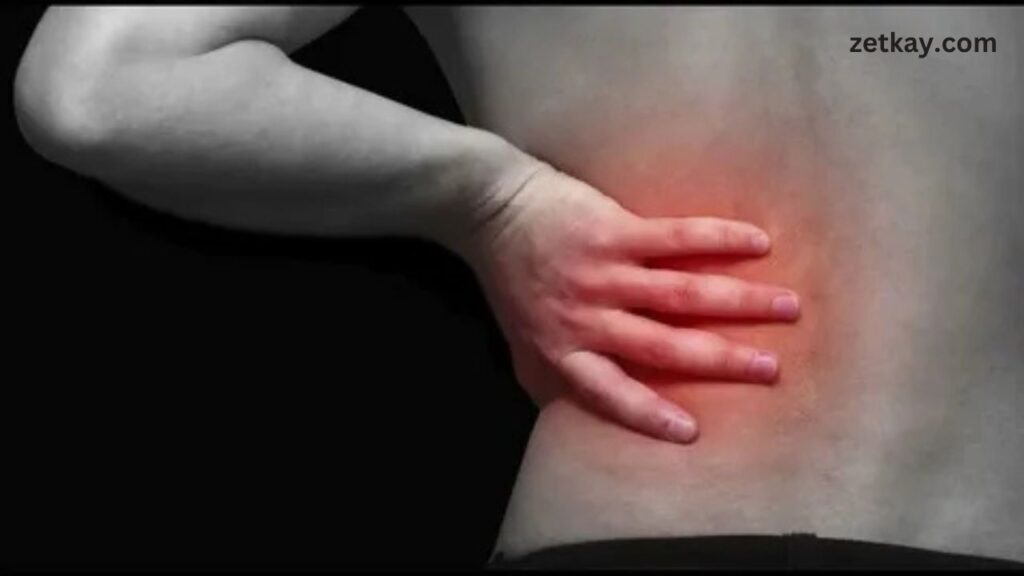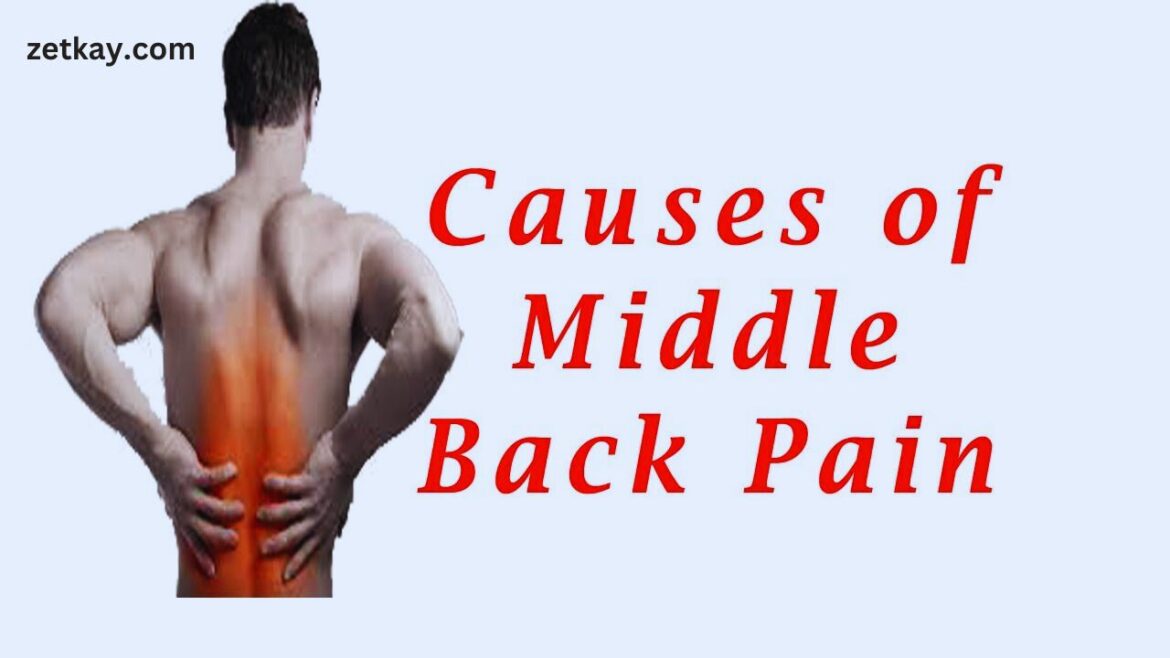Discover the causes, symptoms, and effective treatments for middle back pain. Learn about home remedies, lifestyle changes, and when to seek medical attention to manage and prevent discomfort in the thoracic spine.
Introduction
Middle back pain can range from a dull ache to a sharp, stabbing sensation that interferes with daily activities. Whether it’s caused by lifestyle factors or underlying health conditions, addressing the issue early is crucial to prevent long-term complications. In this guide, we’ll explore the symptoms, causes, and treatment options for middle back pain, including practical home remedies to manage discomfort.
What is Middle Back Pain?
Middle back pain refers to discomfort in the thoracic spine, the portion of the spine between the neck and lower back. The thoracic spine consists of 12 vertebrae, responsible for supporting the ribcage and protecting vital organs. Unlike the cervical or lumbar spine, this area has limited mobility, making injuries and strain more uncommon but still possible.
Understanding the anatomy of this region helps identify possible pain sources and choose the appropriate treatment. Pain in this region often stems from muscular issues, joint dysfunction, or underlying conditions.
Common Symptoms of Middle Back Pain
Middle back pain can manifest in various ways, depending on the underlying cause and severity. Recognizing the symptoms is essential for determining whether simple home care will suffice or if medical intervention is necessary. Here are the most common symptoms:
General Pain Description
Most individuals with middle back pain report a dull, aching sensation between the shoulder blades or around the spine. Others may experience sharp, stabbing pain that can catch them off guard during physical activities or even while resting. This pain may worsen with certain movements, such as twisting or bending, and can become more pronounced after prolonged periods of sitting or standing. If the pain feels localized to one spot or is widespread across the thoracic region, it’s essential to monitor it closely to identify any patterns or triggers.
See Also:
How To Treat Upper Back Pain With Exercise
Radiating Pain
In some cases, middle back pain can radiate to the chest or ribs. This symptom may cause alarm since chest pain is often associated with heart issues. However, radiating pain from the thoracic spine typically stems from muscle strain, nerve irritation, or herniated discs. It’s crucial to differentiate between back-related pain and potential cardiac issues. If you experience shortness of breath or a tight, squeezing sensation in the chest, seek immediate medical attention to rule out heart-related problems.

Muscle Stiffness
Muscle stiffness is a common complaint for those experiencing middle back pain. This stiffness may limit your range of motion, making it challenging to perform everyday tasks like reaching, bending, or twisting. Stiffness is often worse in the morning or after long periods of inactivity. Over time, chronic stiffness can lead to poor posture, which further exacerbates middle back pain. Gentle stretching or heat therapy can help alleviate stiffness and improve flexibility.
Numbness or Tingling
Nerve involvement is a more concerning symptom of middle back pain. If the nerves surrounding the thoracic spine become compressed or irritated, you may experience numbness, tingling, or a “pins and needles” sensation. This can radiate to the arms, chest, or even the legs in severe cases. These symptoms should not be ignored, as they may indicate conditions like herniated discs or spinal cord compression. Prompt evaluation by a healthcare provider is essential to prevent further nerve damage.
Causes of Middle Back Pain
Understanding what causes middle back pain is the first step in finding relief. The following are some of the most common causes of discomfort in the thoracic spine:
Poor Posture
One of the leading causes of middle back pain is poor posture. Prolonged periods of slouching, hunching over, or leaning forward—whether at a desk, on the couch, or looking at a phone—can strain the muscles and ligaments in the middle back. Over time, this poor posture can lead to muscle imbalances, which may cause chronic pain and stiffness. Simple changes, such as using ergonomic furniture and practicing mindful posture corrections, can help alleviate posture-related pain.

Muscle Strain
Muscle strain occurs when the muscles supporting the thoracic spine are overworked or injured. This can result from lifting heavy objects without proper form, sudden twisting motions, or repetitive movements during exercise or sports. Muscle strain is often accompanied by localized tenderness and swelling. Rest, cold therapy, and gentle stretching are typically effective for relieving muscle strain-related pain.
Herniated Discs
Although more common in the lumbar spine, herniated discs can occur in the thoracic region as well. When a spinal disc bulges or ruptures, it can press on nearby nerves, leading to intense pain, numbness, and tingling. Herniated discs may develop due to aging, trauma, or repetitive stress. Treatment may involve physical therapy, anti-inflammatory medications, and, in severe cases, surgical intervention.
Osteoarthritis
Osteoarthritis is a degenerative joint condition that can affect the spine’s facet joints. As cartilage wears down over time, the joints become inflamed and painful, leading to stiffness and limited mobility. Osteoarthritis in the thoracic spine is often accompanied by morning stiffness that improves with movement. Treatment typically focuses on pain management and joint support through exercise and weight management.
Spinal Injuries
Traumatic events such as car accidents, falls, or sports injuries can lead to fractures or soft tissue injuries in the thoracic spine. These injuries can cause sudden, severe pain and may require immediate medical attention. Even minor injuries can lead to chronic middle back pain if not properly treated. Rehabilitation and physical therapy are often necessary to restore strength and flexibility after a spinal injury.
Underlying Medical Conditions
Certain medical conditions can contribute to middle back pain. Scoliosis, a curvature of the spine, can cause muscle imbalances and uneven stress on the thoracic region. Fibromyalgia, a chronic pain disorder, often results in widespread musculoskeletal pain, including in the middle back. Infections, lung conditions, or even gastrointestinal issues can also cause referred pain to the thoracic spine. Proper diagnosis and treatment of the underlying condition are essential for pain relief.
Risk Factors for Middle Back Pain
Certain factors can increase the likelihood of developing middle back pain:
Sedentary Lifestyle
A lack of physical activity weakens the muscles that support the spine, making them more prone to strain and injury. Prolonged sitting, especially in poor posture, can further increase the risk of middle back pain. Regular movement and core-strengthening exercises can help prevent pain caused by inactivity.
Age-Related Factors
As we age, spinal discs and joints naturally lose their flexibility and cushioning. This can lead to degenerative conditions like osteoarthritis, which are common causes of middle back pain in older adults.
Overweight or Obesity
Excess weight places additional stress on the spine and surrounding muscles, contributing to poor posture and increased strain on the thoracic region. Maintaining a healthy weight through a balanced diet and regular exercise can reduce the risk of back pain.
Repetitive Motions
Occupations or sports that require repetitive bending, twisting, or lifting movements can lead to wear and tear on the thoracic spine. Over time, this repetitive stress can cause chronic pain and injury. Proper body mechanics and regular stretching can help minimize the impact of repetitive motions.
When to See a Doctor
While mild middle back pain often resolves with home remedies, certain symptoms warrant prompt medical attention:
- Persistent Pain: If the pain lasts longer than a few weeks or progressively worsens, it’s essential to consult a healthcare provider.
- Nerve Symptoms: Numbness, tingling, weakness, or loss of bladder/bowel control may indicate nerve damage or spinal cord compression.
- Fever or Weight Loss: These symptoms may point to an infection, tumor, or systemic illness requiring immediate evaluation.
A healthcare provider can perform a thorough examination and recommend appropriate diagnostic tests to determine the cause of persistent or severe middle back pain.
Conclusion
Middle back pain is a common issue that can affect people of all ages and lifestyles. Whether caused by poor posture, muscle strain, or underlying health conditions, it can significantly impact daily activities and overall quality of life. Fortunately, many cases of middle back pain can be managed through lifestyle changes, physical therapy, home remedies, and, if necessary, medical treatment.
Understanding the symptoms and potential causes is key to effective treatment. Recognizing risk factors and implementing preventive strategies—such as ergonomic adjustments, regular exercise, and stress management—can help reduce the likelihood of chronic pain.
If middle back pain persists or worsens, seeking medical attention is essential to rule out serious conditions and receive appropriate care. With the right approach, managing middle back pain and improving spinal health is entirely possible.
FAQs
Can stress cause middle back pain?
Yes, stress can contribute to middle back pain. Stress often leads to muscle tension and spasms, which can affect the thoracic spine and surrounding muscles. Incorporating stress-relief practices like deep breathing, mindfulness, and yoga can help alleviate tension-related pain.
How long does middle back pain typically last?
The duration of middle back pain depends on its cause. Mild pain from muscle strain or poor posture may resolve within a few days to weeks with proper care. Chronic or more severe pain, especially from conditions like herniated discs or arthritis, may last longer and require medical treatment.
What are the best exercises for relieving middle back pain?
Gentle stretching and strengthening exercises are often beneficial for middle back pain. Examples include cat-cow stretches, shoulder blade squeezes, and thoracic twists. Core-strengthening exercises like planks can also help stabilize the spine. It’s advisable to consult a physical therapist for a personalized exercise plan.
When should I see a doctor for middle back pain?
You should see a doctor if your middle back pain is persistent, worsening, or accompanied by symptoms such as numbness, tingling, weakness, or loss of bladder/bowel control. Additionally, seek medical attention if you experience fever, unexplained weight loss, or severe trauma to the spine.
Can I prevent middle back pain?
Yes, many cases of middle back pains can be prevented by maintaining good posture, staying physically active, managing stress, and using ergonomic furniture. Regular stretching and core-strengthening exercises can also help support spinal health and reduce the risk of injury.
